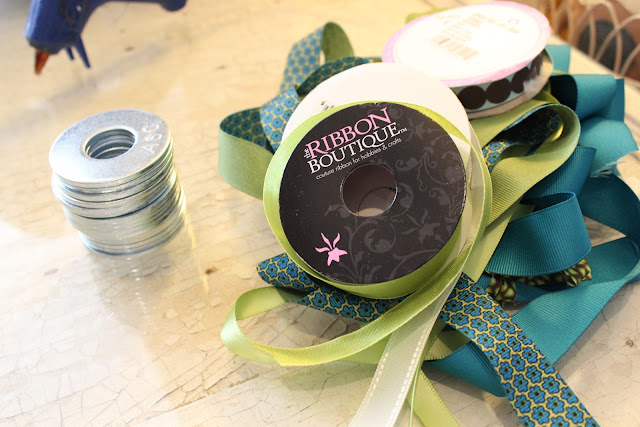Cut the following pieces out of your
main felt color:
Corsage ruffle- One 3" x 9" strip
Ribbons- Two 1 1/2" x 6" strips
Corsage backing- One 3" diameter circle
Cut the following pieces out of your
accent felt:
Ribbon accents: Two 1" x 6" strips
Corsage face: One 2 3/4" diameter circle
You will also need:
6 1/2" piece of pom pom trim
1 medium sized safety pin
Coordinating thread
Scissors/rotary cutter
Chalk or marking pen
Ruler
Embroidery needle and floss/sewing machine with embroidery function
Directions
1. Embroider the message of your choice onto your corsage face, either by hand or using your sewing machine.
2. Pin the pom pom trim onto the wrong side of the face, near the edge.
3. Temporarily sew in place with a basting stitch. Remove the pins and set aside.
4. Fold the corsage ruffle in half, lengthwise. If necessary, pin to hold in place. Mark off 1" increments at the top of the folded edge. Using scissors, cut 1" notches at each 1" mark.
5. Pin the ribbon accent to the ribbons, lining them up down the middle. fold in half lengthwise and make a mark 1/2" up the folded edge. Cut a v-shaped notch in the bottom, up to the 1/2" mark, through both the accent and main ribbon.
6. Topstitch the ribbon accent onto the ribbon. Match your bobbin thread to your main felt color.
7. Pin the ruffle to the outside edge of the corsage backing. Line it up so the bottom of the ruffle
notches are just inside the edge of the backing. Sandwich the ribbons in between the backing and the ruffle, overlapping the tops of the ribbons slightly (you may need to remove a few pins, but I found it easier to pin the ruffle first, then add the ribbons).
8. Next, sew a safety pin to the back of the corsage. I placed a small piece of felt on the inside for reinforcement. You can do this by hand or with your sewing machine. I used my machine and sewed one stitch forward one stitch backward, multiple times, at three different spots along the safety pin.
9. Sew along the edge of the backing circle.
10. Pin the face to the front of the corsage, centering it within the ruffle. Stitch around the edge with a zig-zag stitch. Match your bobbin thread to your main felt color. (You could also use a straight stitch but I wanted to make sure I caught the pom pom trim in my stitch.)
11. Remove the basting stitches from the face.
I made two of these for the grandmas to be at my baby shower, but they would also be great as name tags at a party or for birthdays or bachelorette parties.
You can
purchase your own custom corsage in my etsy shop!
















































